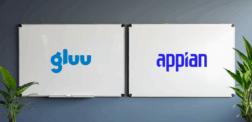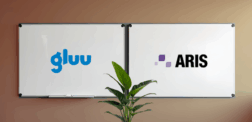
How Gluu helps Zimbabwean companies with process improvement

Gwen Meyer chooses Gluu to help create process documentation and involve both top management and other employees in process improvement. This is the story of how she did it.
Over a period of one year, Gwen helped four companies – three banks, a software company and an accountancy firm. All of this took place in Zimbabwe – a country that has its own very unique problems, which can really challenge even the most innovative business manager. Yet it is exactly the climate where light and flexible process documentation is crucial to top management. To understand this we will take a brief look at Zimbabwe’s business climate as described by Gwen.
African develops fast but Zimbabwe still struggles
Many African countries are making some attempt at progress with reasonable growth rates. These are introduced by a new generation of professionals that has wholeheartedly embraced the new technology. There are even some areas where Africa is progressing in leaps and bounds such as in the area of mobile banking. Nevertheless, when one discusses African innovation Zimbabwe is the last country mentioned.
It takes a substantial amount of corporate manoeuvring to succeed in Zimbabwe as Gwen points out. Anyone familiar with Zimbabwean policy knows doing business here can be very taxing. The persisting political and economic instability led to the emigration of highly trained individuals who find more gainful employment elsewhere. Long-term planning is therefore not easy. The economic problems are having serious effects on businesses who mostly have to cope with limited resources as far as finances, production materials and employees are concerned. Whenever an economy is in a downward spiral this also has a detrimental effect on businesses in that economy.
The local situation and continual labour-related issues and disputes are requiring almost all the time of CEO’s and directors so that very little time remains to develop new strategies for the business. Something which is urgently required is a higher level of user involvement to create ownership, generate ideas and improve processes.
The one positive is that the basic level of education in Zimbabwe is relatively high. A significant percentage of Zimbabwean people are reasonably educated and read and write English competently. Many who are able to afford it take steps to improve their education by obtaining Diplomas or by enrolling for correspondence courses.
People who have distinguished themselves academically or have other specialised skills seek better opportunities elsewhere in order to further their education or to earn higher salaries. This leads to a high turnover of skilled employees.
Where good process documentation and collaboration is a critical success factor
How do companies cope in an environment where regulations fluctuate constantly and where the most skilled employees seek better opportunities elsewhere? Add to this the low salaries coupled with almost nonexistent accountability. The only solution is business processes. Flexible process documentation codifies tacit knowledge and essentially keeps more of the learning with the company.
This is the approach that Gwen took in helping CHIPS Enterprise Solutions and CABS to gain an advantage in the Zimbabwean market. Let’s look at CABS as an example of Gwen’s approach to process documentation and process improvement.
CABS’ business and organisation
Let’s take a brief look at CABS. CABS is an established and strong brand name in the financial retail market in Zimbabwe and is a subsidiary of Old Mutual Zimbabwe, Zimbabwe’s largest Life Assurance organisation. Old Mutual Zimbabwe is, in turn, a subsidiary of Old Mutual PLC – an international financial conglomerate.
CABS offers a diverse range of financial products and services which are delivered through the largest branch network in the country which is linked to CABS online real-time banking.
Fexdec Investments, Rimov Investments and Tradanet Pvt Ltd provide IT and transaction processing, project management and consulting services on behalf of CABS.
As a result of this CABS has a wide range of processes – ranging from setting up retailers on mobile banking to investment planning. Some require highly skilled employees while others include manual work. Add to this that employees work from offices all over the country, are often travelling and find it hard to meet physically to share knowledge. This was the challenging situation that faced Gwen and the senior management team of CABS.
The search for a lean process management solution starts
Given the Zimbabwean business climate, a very simple process improvement tool was needed. Gwen wanted to present something to CABS that was quick and easy to set up. This was about business processes and employee roles – not another IT project. Gwen defined these eight key requirements:
- It should be usable by people without any training. This was vitally important because the average workforce in Zimbabwe will be intimidated by sophisticated systems that required a high level of technical know-how to maintain and operate (just like people across the globe, we would add).
- It would suit a startup but would work equally well with an established business and the solution needed to be affordable and cheap to maintain.
- It should allow process owners and users to own the processes.
- It should simplify online collaboration as well as give uninterrupted improvement.
- It should have a modern user interface.
- Any use of consultants should only be necessary for the initial stages.
- The system should be totally accessible anywhere, anyplace via the cloud.
- It should be fully compliant with ISO 9001 quality standards.
She then started finding and analysing the tools available for the job. This was based on her own experience, a network of contacts – and Google. A list of all potential lean process management tools was compiled. The list was then narrowed down by excluding the ones that were either too difficult or too costly to implement and operate.
In the end, Gwen had a shortlist of some process drawing solutions – essentially online Visio type tools that made it possible to draw process diagrams. And then there was Gluu. Gluu stood out by its ease of use and ease of involving people in creating and using business processes.
In Gwen’s experience, much process work stopped when process documentation was done. The hard part was keeping it up-to-date and ensuring that documentation led to new behaviours and to actual process improvement. Reflecting on this Gluu became the only tool able to enable the full journey. Gluu was presented to CABS’ senior management team and the decision was made to go forward.
Helping CABS’ team to create their own process documentation
Together with CABS’ management team Gwen then prepared a three-step approach that would allow her to step out of the project and let CABS’ employees proceed on their own. The process was simple and short.
Step 1: Deciding on an approach to process architecture
The team had to decide whether they should go for a common process architecture across the group or separate process architectures for each business. The overall direction was to gradually consolidate and share processes across the businesses. This could make it easier to merge processes as well as employee responsibilities and roles into one united entity. At the time, however, the businesses were quite diverse. Therefore, they made the decision to start with creating separate process architectures for each business.
Step 2: Getting middle management onboard and involved
Gwen organised an initial presentation to all key decision-makers and stakeholders, which included process owners. The purpose was to introduce herself and set the scene. The presentation gave an overview of the following topics:
- Introductions
- Case for BPM and Gluu
- Platform Overview
- Identify high priority process as an example to create
- Create Sample Process
- Define Roles
- Map Activities
- Add Tools – Document Why, What and How
- Run Process
- Improve Process (manage users: permissions, collaboration etc.)
The purpose of this was to ensure a common understanding and terminology.
Step 3: Scoping and preparing each process
CABS had a few records of informally documented work instructions which were out of date and did not follow any consistent template or standard. Nor did they know at this stage how many processes they should prioritise for documenting.
As such, Gwen’s next step was to hold a series of workshops and interviews with process owners (from business and functional areas), to the scope and prioritise processes for detailed process mapping and procedure writing, using Gluu.
The goal of these workshops was to gather enough information to enable Gwen to:
- Construct the “Manage Company” high-level Value Chain of all functions across the organisation, including Support processes. A lower-level process architecture.
- Identify and define Sub-processes within each functional area (referred to as Level 1 & Level 2 Node Trees)
- Identify an exhaustive list of procedures under each subprocess node
(Level 3) - Define Critical Success Factors (if required)
- Define Key Performance Indicators and Metrics (if required)
- Prioritise the list of processes for detailed investigation and mapping in line with an agreed pricing plan.
Step 4: Facilitating process mapping
With clear and approved scoping Gwen then organised and held a further series of workshops with business process owners and users. The purpose was to assist and train them in the creation of their processes inside Gluu as well as additional functions such as process linking, inviting collaborators, etc.
How did the workshops go? Many users needed quite a bit of help initially to identify and break down the processes so facilitation was an important aspect in motivating the users. However, they very quickly understood the benefits of the system and picked up the use of the system easily.
Results and perspectives
The Gluu process platform has now been fully accepted by most employees. They are excited about the benefits offered in terms of communication, wider understanding, participation and training. The journey has started towards continuous improvement of processes across CABS’ companies. Gwen has now relocated from Zimbabwe to Adelaide in Australia where she will continue her work. Her four Zimbabwean clients on the Gluu platform are now managing processes on their own. They rarely need support, but when they do they simply send questions to Gluu’s support desk in Copenhagen.
 Gwen’s background and experience…
Gwen’s background and experience…
Gwen Meyer has worked in business and IT consulting for over 25 years, across a range of industry sectors, and have held a variety of roles in major change projects in Zimbabwe, Australia, South Africa and the UK. She has helped organisations achieve their business goals through transformation – from identifying the current operational model, shaping the future operating model through to delivering the changes in areas requiring innovative, yet practical, solutions. Her recent experience has included business process review and improvement, business model development, project methodology and process training and project management for ERP implementations.
This article about process improvement was based on an in-depth interview with Gwen.
Frequently Asked Questions
The Partner Case Process Improvement model qualitatively measures progress through several mechanisms. These include monitoring specific metrics relating to performance and efficiency, employee feedback, and comparing pre and post-implementation scenarios. The model also targets improvements in customer satisfaction levels, which is another essential quantitative measure of progress.
Gluu employs several strategies to counteract resistance or pushback from employees in organizations. They prioritize transparent communication about the benefits and implications of the process improvement model to increase employee buy-in. Moreover, they offer thorough training and support to ensure everyone understands how to utilize the new systems effectively. By addressing concerns directly and demonstrating the value of the improvements, Gluu works to alleviate any reluctance employees might feel towards the new model.
Yes, Gluu designed its platform to seamlessly integrate with various existing systems and tools within its partner organizations. This feature minimizes disruption to day-to-day operations during the transition period. It also helps maintain maximum productivity as employees acclimate to the new processes, leading to higher adoption rates.



